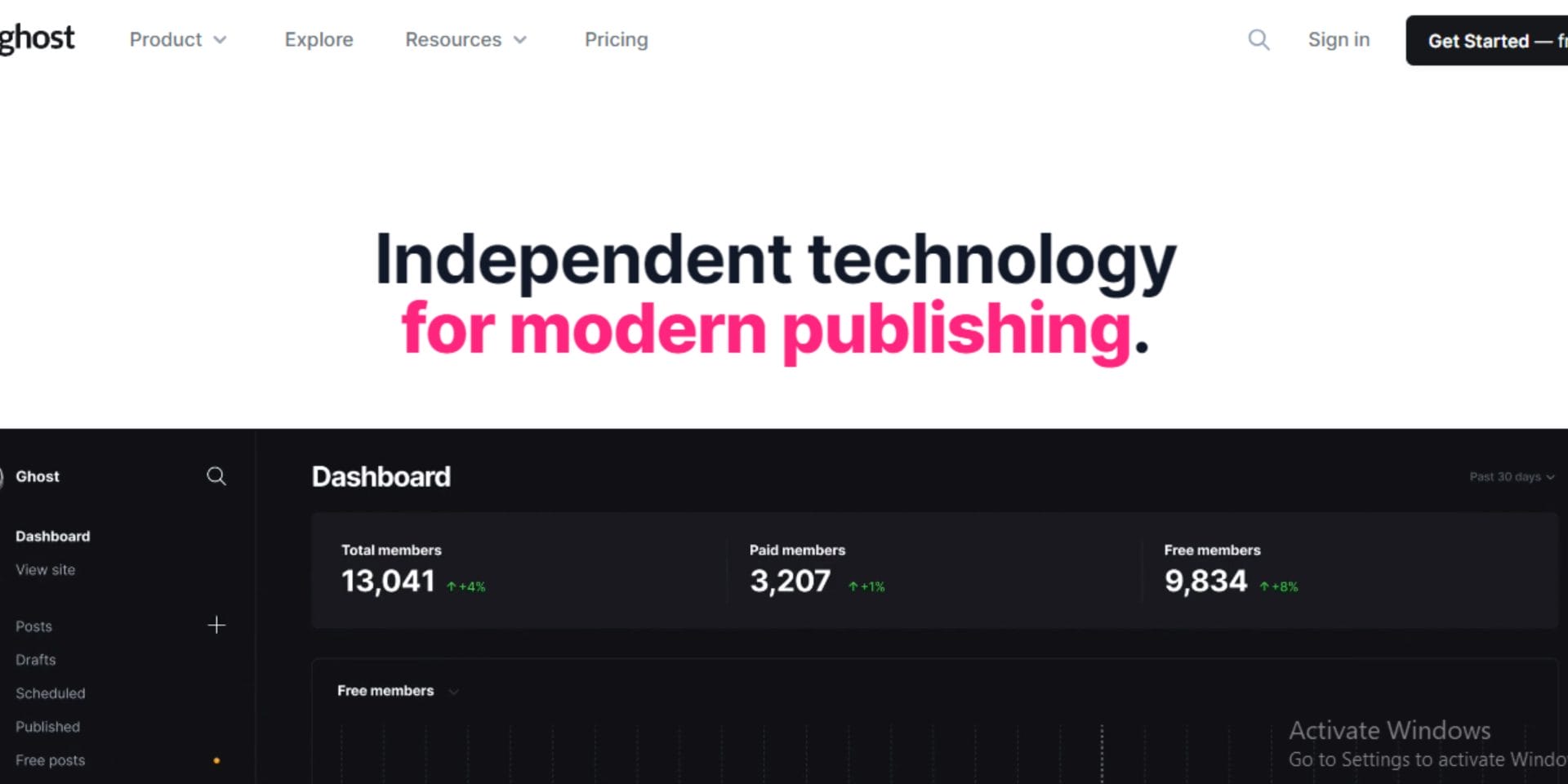If you’re a writer looking to build your own audience and share your content through a blog or newsletter, you might be considering platforms like Substack vs Ghost. Along with WordPress, these platforms are among the most popular options available. However, it’s important to understand the differences between Substack and Ghost before making a decision.
In this comprehensive guide, we’ll compare Substack and Ghost in four key areas: their basic approaches, features, setup processes, and pricing. By the end of this article, you’ll have a clear understanding of which platform is best suited for your needs, knowledge level, and budget.
Substack: A Hosted Approach to Blogging and Newsletters

Substack is a hosted newsletter and blogging service that allows you to create and manage your content without the need for technical configurations. Unlike self-hosted platforms like Ghost and WordPress, Substack takes care of all the technical aspects for you.
With Substack, you can easily start writing and publishing content by simply signing up for an account. The platform provides a user-friendly dashboard where you can manage your newsletter and blog. Substack focuses on three core features: blogging, newsletters, and member management.
You can accept both free and paid subscribers, and choose whether to make your content available to everyone or restrict it to paying subscribers. The platform also enables you to send your content as newsletters to your subscribers.
However, Substack has some limitations in terms of design customization and integrations. While you can make basic color choices for your site, you can’t fully customize its design. Additionally, Substack doesn’t offer extensive integrations with third-party services.
Ghost: Free and Open-Source Software for Ultimate Flexibility

Ghost, on the other hand, is free, open-source software that provides you with complete control over your website. It’s similar to self-hosted platforms like WordPress, allowing you to download the Ghost software for free and install it on your own web hosting.
To make Ghost more accessible to non-technical users, the Ghost team also offers a paid service called Ghost Pro. With Ghost Pro, you can enjoy a more streamlined experience similar to Substack, as the Ghost team handles hosting and maintaining the software for you.
Ghost offers the same core features as Substack, including blogging, built-in newsletter support, and member management. However, Ghost goes beyond Substack in terms of flexibility and customization.
With Ghost, you have access to a wide range of themes that allow you to fully customize your site’s design. You can choose from pre-made themes or even hire a developer to create a custom design for your Ghost site. Additionally, Ghost offers extensive integrations with third-party services, allowing you to expand the functionality of your site.
Ghost’s flexibility also extends to monetization options. In addition to subscription revenue, you can integrate Google AdSense to monetize your content with ads, providing you with additional revenue streams.
Features: Substack vs Ghost
When it comes to features, Substack and Ghost offer different levels of flexibility and customization.
Substack Features
Substack focuses on its core features of blogging, newsletters, and member management. While the platform provides a straightforward and user-friendly experience, it has limitations in terms of design customization and integrations.
With Substack, you can easily accept both free and paid subscribers. You have the option to make your content available to everyone or restrict it to paying subscribers. Substack also allows you to send newsletters to your subscribers.
However, Substack’s design options are limited. You can only make basic color choices for your site, and you can’t fully customize its design. Additionally, Substack has minimal integrations with third-party services.
Ghost Features
Ghost offers the same core features as Substack, including blogging, built-in newsletter support, and member management. However, Ghost provides more flexibility and customization options.
With Ghost, you can choose from a wide range of themes to fully customize the design of your site. Whether you prefer pre-made themes or a custom design, Ghost allows you to create a unique and visually appealing website.
Ghost also offers extensive integrations with third-party services. You can connect your Ghost site with various apps via the Zapier integration, enabling you to automate processes and enhance your site’s functionality. This includes integrating with Patreon to offer premium content to your subscribers.
Additionally, Ghost provides a rich writing experience with its editor. You can easily add various elements to your content, such as restricted email-only content, public previews, images, image galleries, and embeds from third-party sources like Twitter, YouTube, and Spotify.
Setup Process: Substack vs Ghost
When it comes to the setup process, Substack and Ghost offer different experiences.
Substack Setup
Getting started with Substack is incredibly easy. All you need to do is register for an account, and you can start managing your newsletter and blog from a simple dashboard. The platform provides a basic text editor that allows you to create and publish content.
Ghost Setup
Ghost offers two different setup approaches: Ghost Pro and self-hosting.
With Ghost Pro, the setup process is simplified. After signing up for a Ghost Pro account, you’ll be guided through an onboarding wizard to set up key details. Once completed, you’ll have access to the Ghost dashboard, where you can manage all aspects of your site.
If you choose to self-host the Ghost software, the setup process requires more technical knowledge. However, it provides you with complete control over your platform. You’ll need to install the Ghost software on your own web hosting and configure it according to your preferences.
To customize the design of your Ghost site, you can choose from a variety of themes. Uploading a theme file is a straightforward process. Ghost’s editor offers a distraction-free interface for writing and allows you to add various elements to your content.
Pricing: Substack vs Ghost
Substack and Ghost have different pricing models that cater to different needs and budget considerations.
Substack Pricing
Substack is free to get started. You can register for an account and begin publishing content without any upfront costs. However, when you start accepting paying subscribers, Substack will take a 10% cut of all subscription revenue you collect. This can become costly as your audience and revenue grow.
Ghost Pricing
Ghost offers the Ghost Pro service for those who prefer a more streamlined experience. With Ghost Pro, you’ll need to pay an upfront fee based on the number of visits your site receives, the number of staff members you have, the features you need, and the number of members/subscribers you have.
The Ghost Pro pricing plans range from $9 per month ($108 per year) for the basic plan to $199 per month ($2,388 per year) for the highest-tier plan with over 8,000 subscribers. While there is an upfront cost, Ghost doesn’t charge any ongoing commissions based on your paying subscribers. This means you get to keep all of your subscription revenue.
Conclusion
In conclusion, both Substack and Ghost offer unique approaches to creating blogs and newsletters. Substack provides a simple and user-friendly experience, making it ideal for writers who want to focus on content creation without technical complexities. However, Substack has limitations in terms of design customization and integrations, and its ongoing commissions can become expensive as your audience grows.
Ghost, on the other hand, offers more flexibility and customization options. With Ghost, you have complete control over your website’s design and can choose from a wide range of themes. Additionally, Ghost provides extensive integrations with third-party services, enabling you to enhance your site’s functionality. While there is an upfront cost with Ghost Pro, you can keep all of your subscription revenue.
Ultimately, the best platform for you depends on your specific needs, knowledge level, and budget. If you prioritize simplicity and ease of use, Substack may be the better choice. However, if you value flexibility and customization options, along with the ability to keep all of your subscription revenue, Ghost is the superior option.
Consider your goals, preferences, and long-term vision for your blog or newsletter when making your decision. Whichever platform you choose, both Substack and Ghost offer valuable tools for writers to share their content and build their audience.
Interesting Reads:
11 Best Social Media Plugins For WordPress
